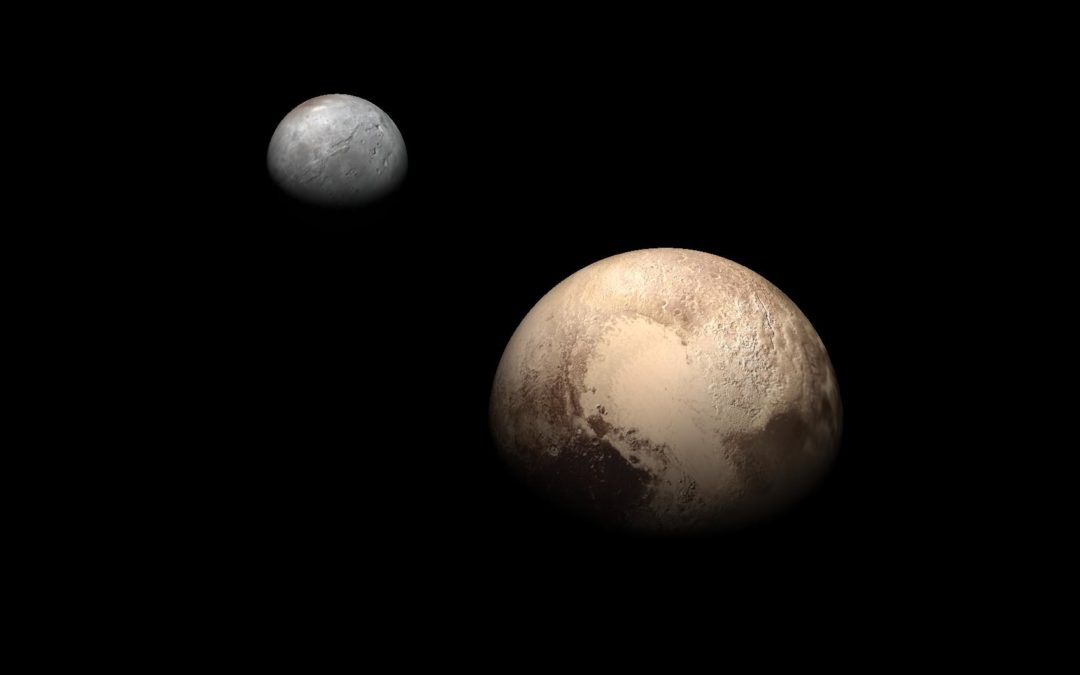Previously, we reviewed the fascinating history of the discovery of Pluto. It is truly amazing how much scientists were able to learn about this distant world considering it appears as a faint point of light in even the most powerful ground-based telescopes. The New Horizons mission would forever change the way we think about this little world. But in the same year that New Horizons was launched, the International Astronomical Union voted to reclassify Pluto as a dwarf planet. What exactly prompted this demotion of Pluto?
The Rise and Fall of the Ninth Planet
For sixty years after its discovery, Pluto was unique in our solar system. We knew of the small, rocky worlds that orbit close to the sun, and the large gas giants and ice giants that orbit far from the sun. Pluto is neither. It is a solid world, like the inner planets, but Pluto is made primarily of ices rather than rock, and orbits at a tremendous distance. Its orbit is more elliptical than the eight classical planets and is not in the same plane. And, significantly, it is far smaller than even Mercury. With all of its weirdness, does it make sense for it to be classified as a planet?
When the first four asteroids were discovered in the first decade of the nineteenth century, they too were classified as planets. But they were found to be far smaller than any (other) planet. The largest asteroid, Ceres, is only 584 miles in diameter. The others are substantially smaller. When even more asteroids were discovered, it became clear that these were quite different from the much larger planets. Rather, they were merely the largest of thousands of objects orbiting the sun, mostly in between the orbits of Mars and Jupiter. So, these small orbiting bodies were reclassified as “minor planets” or “asteroids.” They represent a family of objects distinct from the four inner planets, and the four outer, giant planets.
But Pluto doesn’t quite fit anywhere. It is three times the diameter of the largest asteroid, but only half the size of the (next) smallest planet (Mercury). Had its true size been known at the time of its discovery would it still have been classified as a planet? Yet, its classification as an asteroid seems equally strange since no asteroid is as large or orbits at such a large distance. So, despite the more recent estimates of Pluto’s small size, it remained classified as a planet since it was totally unique in the solar system… until 1992.
The 1990s was the era of the charge-coupled device – the CCD. This new invention was able to capture photons and render a digital image. It was much faster and more sensitive than film. Photographs of faint astronomical objects that would take hours of exposure on film could be done in minutes with a CCD. Consequently, the CCD was able to image much fainter objects than would be possible with film. The technology continued to improve, and the price of CCDs continued to drop. Today, you probably have one as part of the camera in your smartphone.
In 1992, using a CCD with the 2.2-meter telescope at Mauna Kea, Hawaii, astronomers discovered a small solar system body orbiting the sun beyond Neptune. Designated 1992 QB1, this little world was only 100 miles in diameter – far too small to be classified as a planet. QB1 had evaded detection in previous surveys because it is thousands of times fainter than Pluto. But it demonstrated that Pluto was not the only thing orbiting beyond Neptune. Could other small orbiting bodies exist in the outskirts of the solar system? The discovery prompted other astronomers to search for objects beyond Neptune: trans-Neptunian objects (TNOs).[1]
In 1993 several additional TNOs were discovered. By the year 2000, over ninety had been discovered. One of them, Haumea, was found to be 435 miles in diameter, larger than all asteroids except Ceres. It was becoming clear that Pluto was part of a family after all – a very large family. Today, we know of over 2000 TNOs. So, Pluto is the largest member of the TNOs, just as Ceres is the largest asteroid. But traditions die hard, and Pluto had been classified as a planet for seventy years. And since it was larger than any other TNO, its status as a planet could be justified due to its size.
The dilemma came in 2003, when astronomers discovered Eris – a TNO that was estimated to be slightly larger than Pluto.[2] It seemed ridiculous to consider Pluto a planet when the larger Eris was not. Should Eris be classified as the tenth planet, or should Pluto by reclassified as something else? By this time, several other TNOs were known to be nearly as large as Pluto. If Eris were to be considered the tenth planet, should these other fairly large TNOs also be promoted to planethood? What is the size cutoff for a planet anyway? And are there other factors?
In 2006, the International Astronomical Union (IAU) decided that, rather than promoting five to twenty TNOs to planethood with some sort of arbitrary size cutoff, it was simpler to reclassify Pluto. The vote was not unanimous by any means, but most astronomers now agree that this was the right call. The IAU also provided a formal definition of a planet, and came up with a new classification for Pluto: dwarf planet.[3] A dwarf planet is anything that is large enough to be round by its own gravity, and which orbits the sun directly, but which has not cleared its orbit of similarly sized objects. By this definition, our solar system has five (known) dwarf planets. Four of these are the TNOs: Pluto, Eris, Makemake, and Haumea. Since Ceres is also large enough to be round, it too is now classified as a dwarf planet. All these objects have dual classification. Pluto is both a TNO and a dwarf planet, just as Ceres is both a dwarf planet and an asteroid.
New Horizons
In the same year that Pluto was demoted, the first and only mission to Pluto was underway. The New Horizons team designed an unmanned spacecraft about the size of a grand piano, and launched it in 2006 on a journey to Pluto. The New Horizons craft was aided by a gravitational assist from Jupiter, which increased its speed by 9000 miles per hour and reduced the time of its journey by three years. The craft would reach Pluto in nine years, covering a distance of 3 billion miles. If all went well, in July 2015, humanity would be treated to the first detailed images of Pluto. For the first time since the Grand Tour of the 1980s, a spacecraft would transmit never-before-seen images of a world billions of miles away.

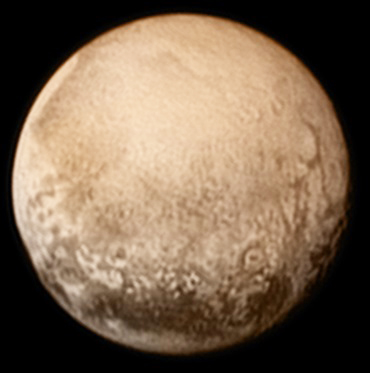
The New Horizons mission was a spectacular success. And we now have detailed, high resolution images of Pluto as well as Charon. Since Pluto rotates every 6 days, New Horizons was able to photograph much of one hemisphere at a greater distance, and most of the other hemisphere in much higher resolution as it passed by Pluto, and similarly for Charon. Consequently, the northern hemisphere of Pluto is completely mapped with varying degrees of clarity.[4] Due to Pluto’s extreme tilt, most of its southern hemisphere was in darkness during the flyby. So, its features remain a mystery. Fortunately, the side of Pluto photographed in highest resolution by New Horizons contained the most spectacular features.
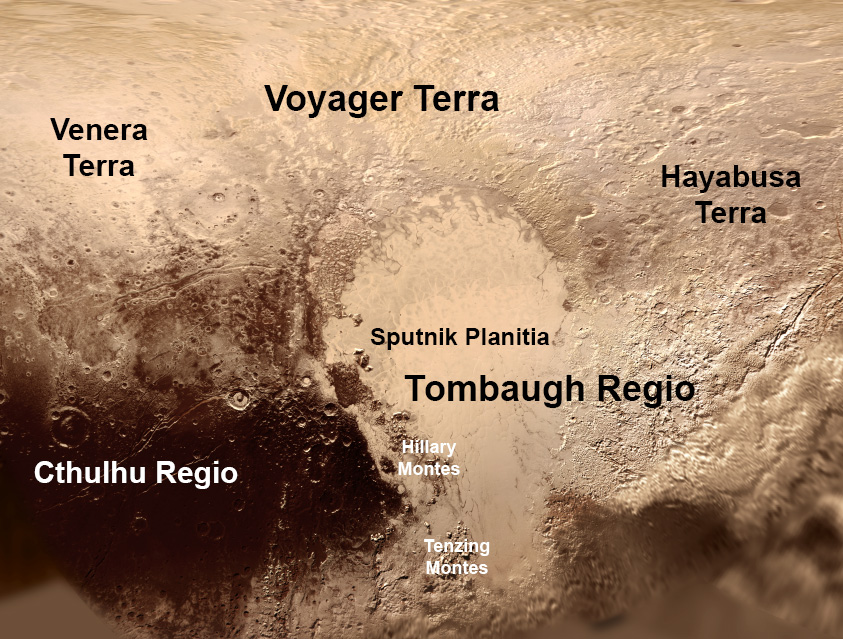
Most prominent is an enormous heart-shaped feature named Tombaugh Regio. It is significantly lighter in color than the surrounding terrain, and smoother. The left lobe of the “heart” is named Sputnik Planitia; it is particularly smooth and exhibits a polygonal tessellation, never before seen on a planet. The pattern resembles an irregular honeycomb, much like the pattern of granulation seen on the surface of the sun. The right lobe of Tombaugh Regio is more rugged, and slightly less red in color.
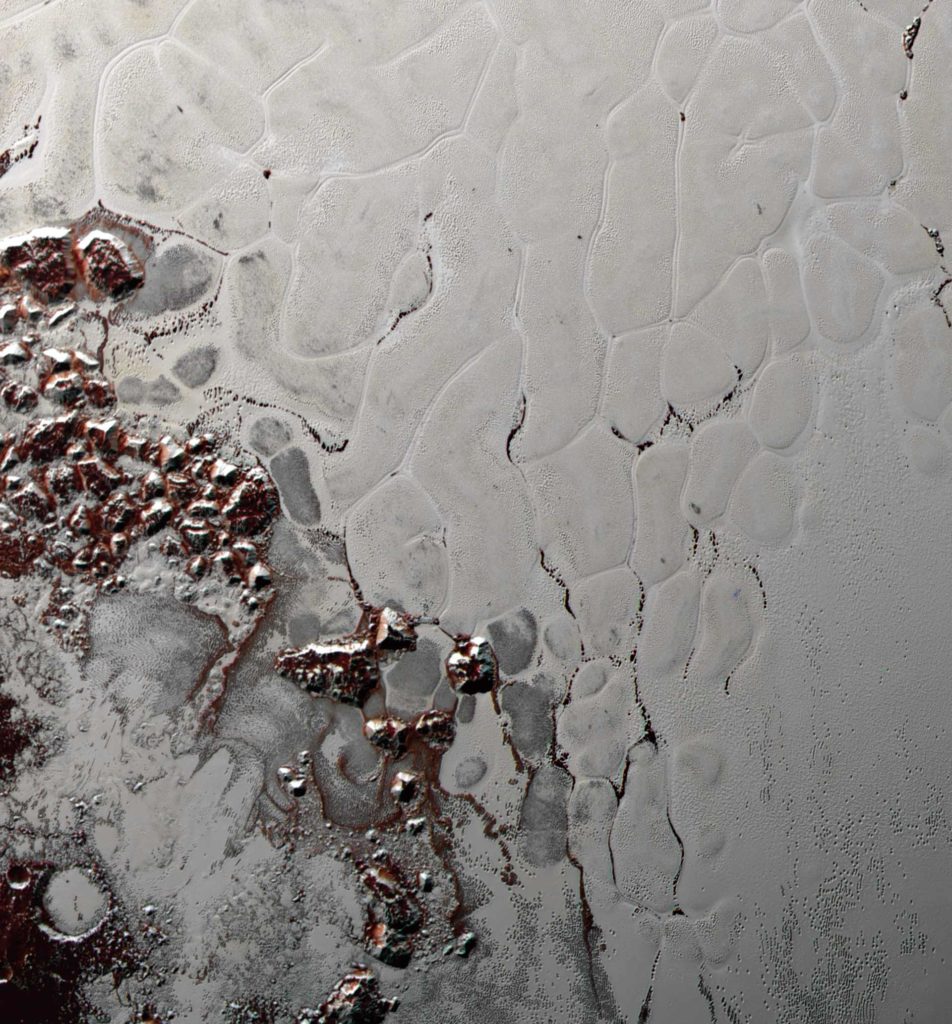
The southwestern perimeter of Tombaugh Regio contains a large mountain range named Hillary Montes. The Tenzing Montes range just south of Hillary Montes contains the tallest and steepest mountains on Pluto. They are comparable in size to the Rocky Mountains. However, mountains on Pluto are thought to be composed primarily of water-ice, covered with a thin layer of frozen nitrogen and methane. The cold temperatures on Pluto make water-ice as hard as rock is on Earth.
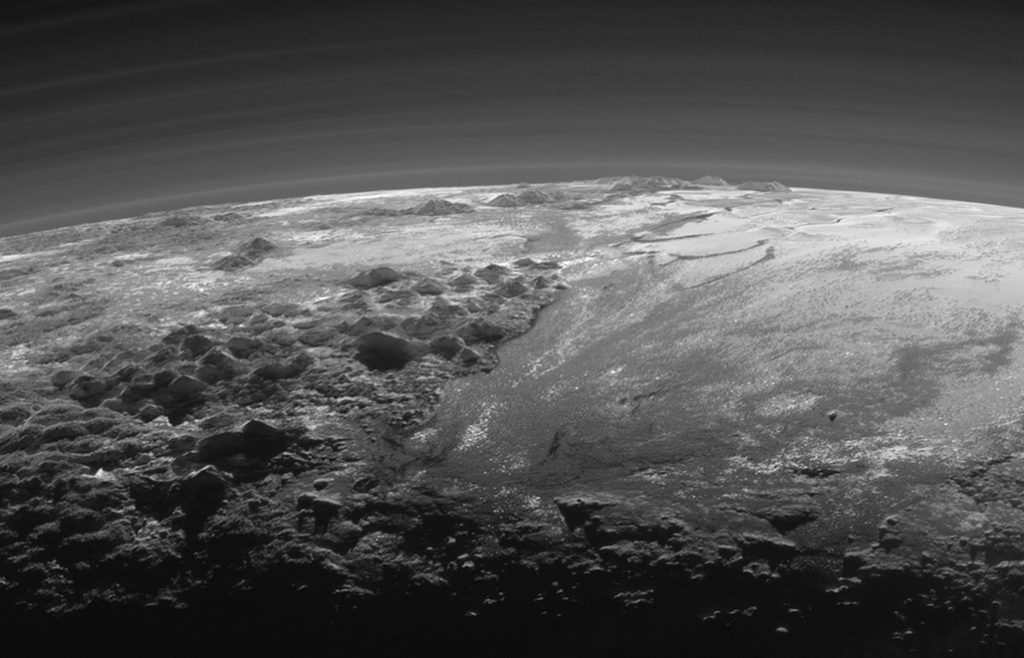
To the lower left of Tombaugh Regio lies the extensive Cthulhu Regio. It is a very large, dark terrain that follows Pluto’s equator. Above Cthulhu Regio is the lighter Venera Terra, which has a number of visible impact craters. Both Venera Terra and Cthulhu Regio have several long chasms. The New Horizons spacecraft was also able to photograph Pluto’s tenuous nitrogen atmosphere.
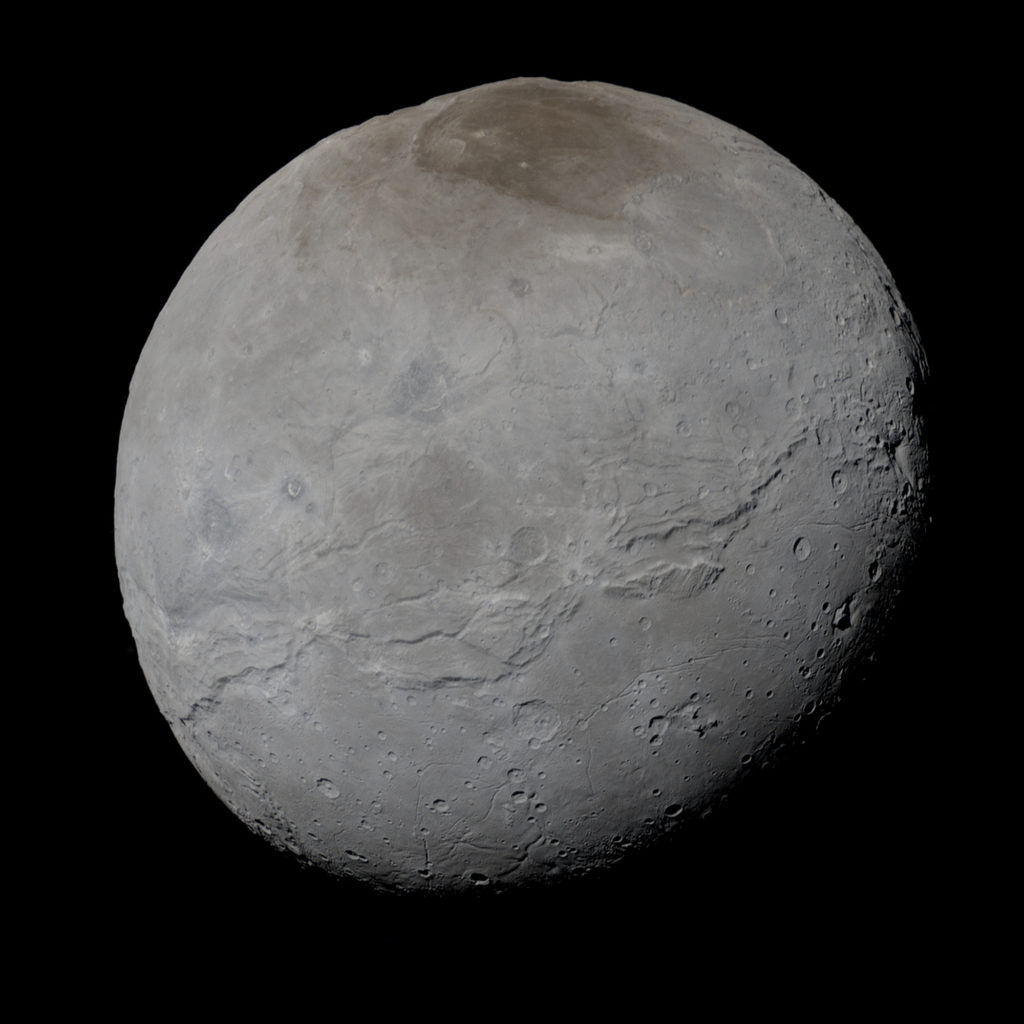
New Horizons also obtained spectacular images of Pluto’s largest moon, Charon. Like Pluto, the surface of Charon has mountains and chasms, along with some impact craters. Charon also has a dark brown north pole, something never before seen on any world, and given the provisional name Mordor Macula. The New Horizons team suggested provisional names for the features on Charon based on characters and locations from science fiction and fantasy books, films, and television. Consequently, you will find craters on Charon labeled “Spock,” “Kirk,” “Skywalker,” “Ripley” and so on. The IAU has yet to officially approve most of these names.
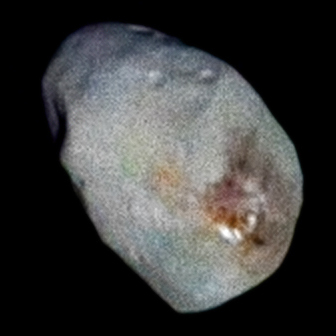
New Horizons also transmitted images of Pluto’s other four moons. As is common for smaller moons, they are non-round. These New Horizons snapshots are likely the only high-resolution images of these moons you will ever see. Contrary to secular expectations, New Horizons found that none of these moons are tidally locked, nor are they chaotic rotators like Saturn’s Hyperion. Instead, each moon rotates with its own unique period. Nix rotates backwards.[5]

Amazingly, all of Pluto’s moons are in at least approximate resonance. Charon, of course, is tidally locked and therefore in a perfect 1:1 resonance with Pluto’s rotation. Styx is in an approximate 1:3 resonance with Charon; Charon orbits approximately three times for every one orbit of Styx. Hydra and Nix are in a 2:3 orbital resonance. Kerberos is in a nearly perfect 1:5 resonance with Charon. Hydra is in a 1:6 resonance with Charon, and therefore a 5:6 resonance with Kerberos. Styx is in an approximate 11:9 resonance with Nix.
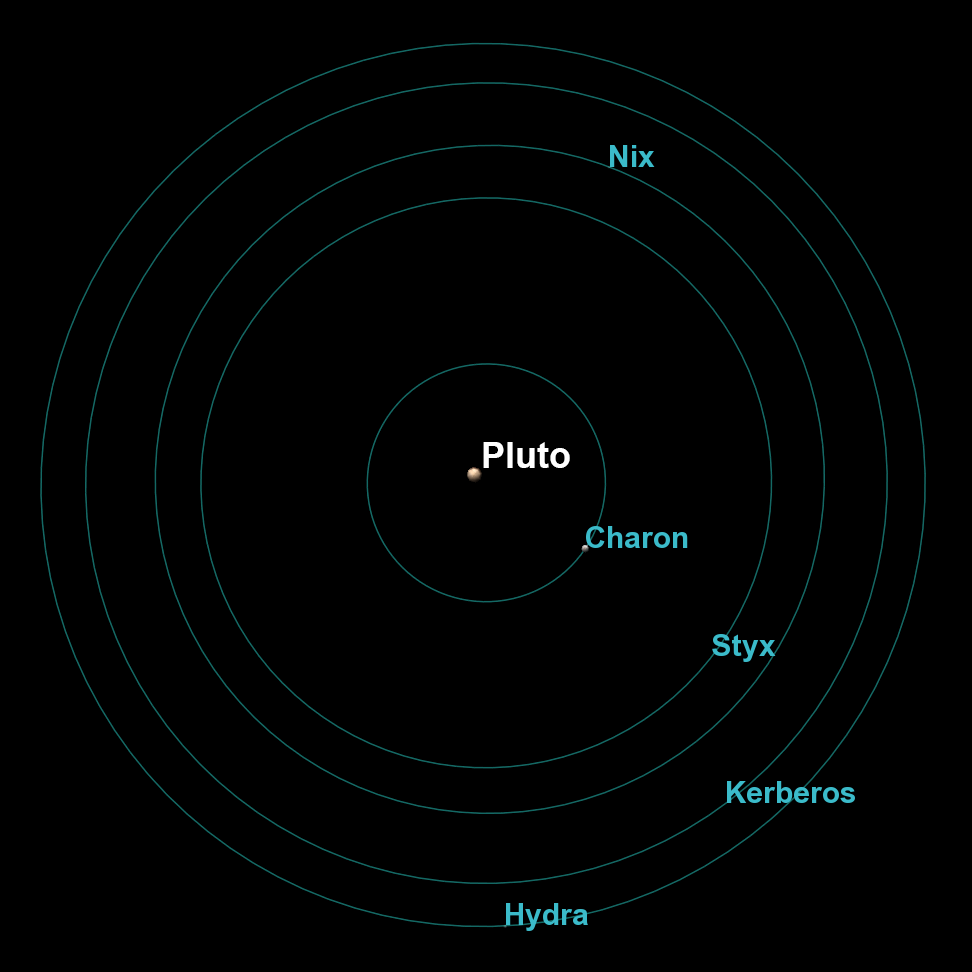
Expectation vs. Reality
Biblical creationists expect to find examples of the Lord’s creativity as we continue to explore His creation. But the data New Horizons transmitted from Pluto is quite perplexing to those who hold to a secular, old-universe narrative. If Pluto were 4.5 billion years old as secularists believe, it would have lost any internal heat ages ago. With no heat to drive geology, Pluto was assumed to be a cold, dead world. And given the number of TNOs that orbit in the vicinity of Pluto, secularists expected it to be completely covered with craters. After all, over 4.5 billion years, a lot of objects should have impacted Pluto, and with no active geology to erase such craters, they should still be there.
This is why the surfaces of Pluto and Charon turned out to be so surprising and perplexing to secular astronomers. Instead of being covered with craters upon craters, each world had relatively few, as if they have experienced only a few thousand years of impacts rather than billions. In fact, Sputnik Planitia on Pluto has not a single crater in it. And it is an enormous region.
Furthermore, both Pluto and Charon have a scarcity of small-scale craters. This is very significant because secular astronomers have assumed that small trans-Neptunian objects are the source for new comets, since a comet cannot last millions of years and yet we have lots of them. Yet, all the TNOs so far discovered are much larger than comets. Secularists assumed that these were merely the tip of the iceberg, and that trillions of undetected smaller objects also comprise the space beyond Neptune. But the scarcity of small craters on Pluto and Charon suggests that such small TNOs are in fact quite rare, and therefore cannot be a significant source of short-period comets.
Moreover, both Pluto and Charon have evidence of recent geological activity, which would be impossible for such small, distant worlds if they were actually billions of years old. Both Pluto and Charon have chasms and mountain chains. The polygonal tessellation so evident in Tombaugh Regio is indicative of convection – the overturning of cells due to internal heat. None of these facts make any sense in the secular narrative. But they do confirm the biblical timescale.
Conclusion
Pluto is an amazing little world, one totally unknown to humankind before 1930. Isn’t it wonderful that the Lord has placed gems of His creative work not only on Earth, but in distant space to be discovered over time? Who knows what other wonders God has placed in His creation that are currently known only to Him? If and when we find some of these, they will continue to confirm biblical creation. In the next article we will explore asteroids.
[1] A TNO is any non-comet orbiting the sun directly at a greater average distance than Neptune.
[2] Today, revised measurements of the diameter of Pluto show that it is slightly larger than Eris. However, Eris is estimated to be more massive than Pluto.
[3] Most astronomers believe that the IAU’s definition of a planet is not quite satisfactory. Further revision may be in order. The current proposed definition of a planet is a world that orbits the sun directly, is in hydrostatic equilibrium (its gravity makes it round) and has cleared the neighborhood of its orbit. The first two criteria are good; the third is troublesome because what constitutes “cleared?” The moon is quite large and orbits at the same average distance as Earth. Furthermore, the gravitational force on the moon by the sun is larger than the force of the Earth on the moon. So the Earth and moon could be considered as both orbiting the sun directly, but mutually perturbing each other’s orbit. In that case, by the IAU definition, the Earth would not be considered a planet.
[4] Pluto’s northern hemisphere is here defined by the right-hand rule.
[5] Nix’s rotation is retrograde – opposite the direction in which it orbits.

